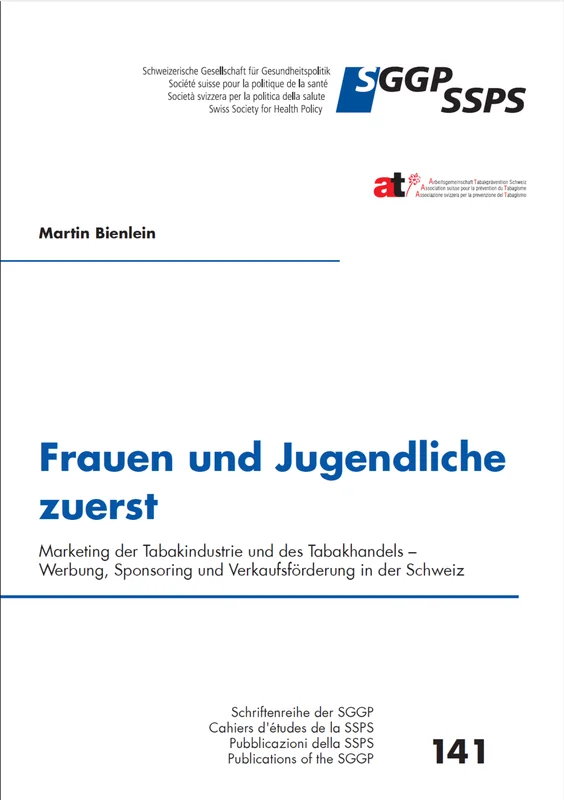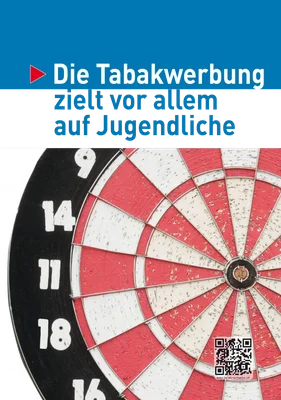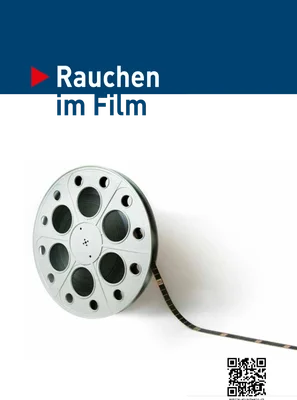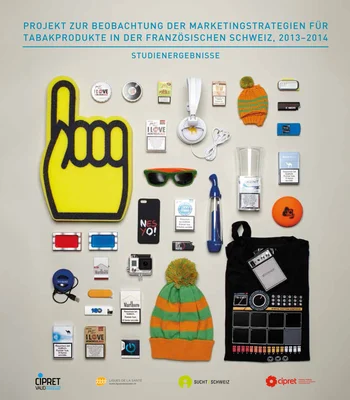Tobacco industry marketing
Frauen und Jugendliche zuerst. Marketing der Tabakindustrie und des Tabakhandels – Werbung, Sponsoring und Verkaufsförderung in der Schweiz (Volume 141)
Martin Bienlein
Bern 2021, 538 pages, with many pictures
ISBN 978-3-85707-141-6

The tobacco industry denies that it targets children and young people with its marketing instruments. Their marketing tools and internal documents show a different picture. The second main target group, women, especially young women, is also well documented. The marketing of the tobacco industry and tobacco retailor is broad, with many measures employed in Switzerland. The tobacco industry has been playing all chors of marketing for a hundred years, using always the latest marketing tunes.
Virtual Marketing
The four big tobacco companies (Big Tobacco), i.e. Philip Morris International, Japan Tobacco International, British American Tobacco and Imperial Brands - formerly Imperial Tobacco, used social media influencers in the 2010s to reach and appeal to their younger audiences, children and youth. Often, the tobacco industry uses young women to advertise their products; in Switzerland, this was the case with the fashion model Tamy Glauser. The unse of social media is a means of appealing to the youth. Tobacco companies, especially Big Tobacco, but also the Swiss cigar manufacturers Oetinger Davidoff and Villiger Söhne exploit electronic marketing channels as well as classic ones, namely the press. Tobacco companies can be seen on various social media platforms, mostly Instagram but also Facebook and Twitter. YouTube and TikTok are filled with videos on smoking and e-cigarette consumption. The tobacco companies use hashtags to reach more potential customers and to spread their marketing content. They present themselves on their internet homepages as socially and environmentally responsible towards investors and potential employees. The Swiss tobacco manufacturers, supermarkets, tobacco shops and recently also a chain of kiosks are using their websites to sell tobacco products.
Product placement
Big Tobacco has always paid actors and productions to promote their cigarettes and cigars. Product and brand placement take place in video games, music videos, films, and on streaming services such as Netflix. Tobacco companies are thus conveying that smoking cigarettes and, increasingly, the consumption of e-cigarettes are normal and socially acceptable.
Point of Sale
In addition to the classic points of sale, namely the supermarkets, kiosks and vending machines, there are single brand stores and flagship stores as well as websites. The point of sale (POS) remains decisive, because this is where the actual purchase decision is made. POS are consequently full of tobacco marketing instruments, e.g. promotions and competitions.
Event Marketing
Event marketing by Big Tobacco in Switzerland often takes place at open-air music festivals. Only recently the festivals started to break away from Big Tobacco and Alcoholics funding, for example the Gurten Festival in Bern, Vernier sur Rock in Geneva, Baleinev Festival in Yverdon-les-beains, Festival de la Cité in Lausanne, La- Plage-de-Six-Pompes in La-Chaux-de-Fonds. Tobacco companies organize and pay (private) parties. Another youth-oriented event was Hack Zürich (2020) cosponsored by Philip Morris International.
Sponsoring
The tobacco industry is big in sponsoring sports. Formula 1, tennis, motorcycle and truck races at the forefront. The Swiss cigar manufacturers Oetinger Davidoff and Villiger Sons are also involved. Tobacco sponsorship in cultural events and entertainment is extremely wide-reaching, including the well-known Montreux Jazz Festival. There is no lack of sponsoring for art, art festivals, art fairs, art museums, art exhibitions and artists. Since smoking and e-cigarette consumption is less and less tolerated in the public sphere, the tobacco industry is sponsoring and therefore securing smoke-friendly zones, for example the smoking lounge at Zurich Airport.
Social Marketing, especially Corporate Social Responsibility CSR
The tobacco industry has been engaged in social marketing (public relations) for about seventy years and currently exploits the United Nations' sustainability goals. In its corporate social responsibility, big tobacco practices whitewashing, by covering up their unethical behavior towards tobacco farmers in low-income countries. They greenwash their catastrophic environmental practices throughout the production chain and healthwash their pathogenic and fatal products. Recently, during the coronavirus pandemic, they exploited the opportunity to be active in crisiswashing.
Classical ads and Brand Stretching
Tobacco advertising and advertisements on the Internet (IQOS, EPOK) are recent means of marketing. They complement the classic advertisements in newspapers, magazines, smokers' magazines, trade magazines, supplements (on paper or electronically) and billboard advertisement. The marketing of things is not new, be it an ashtray or a gadget, be it on clothes or a chewing gum cigarette for children. Brand stretching has passed its heyday . Now the tobacco companies prefer to remain undetected (Davidoff for perfume, Camel and Marlboro for clothes).
Place
Apart from the visible promotions at the point of sale and apart from the store concepts, the place of tobacco marketing remains opaque. Restrictions on the tobacco marketing, however, increase the importance of the distribution policy, when the salespersonal in the retail shops has to secure and increase the sales.
Product Policy
Product policy, together with advertising, is the mainstay of marketing: concerning brands, images, packages, colors and, more recently, with the electrical devices, designs. Product policy has been and still is managed internationally. Another marketing instrument of product policy are the special editions (of packages). All tobacco companies run them. A further product element are flavors, which are growing in importance in the marketing for e-cigarettes, tobacco heating products and oral tobacco. The first significant product change was the widespread introduction of the cigarette-filter, which was introduced as a marketing tool, not a health tool. This also applies to later product adjustments, such as slim, light and ultra-light cigarettes.
Price Policy
Every brand of cigarettes and cigars has its place in the corporate pricing policy. The prices and brands are tailored to target groups. Low price cigarettes are conceptualized for young people.
Marketing-Mix – the example of IQOS
For the tobacco heating product IQOS, Philip Morris drives the full marketing program of promotion, product, place and price policy. As a luxury brand, IQOS is costly and currently designed as an electronic device in metallic colors. Models used to present the product are predominantly young women. Instagram und virual marketing play a central role. The tobacco company uses events intensively.
Ever selling marketing themes and images
The themes and messages used by the tobacco industry have been the same for over half a century. Health continues to be the fore front, now under the motto of harm reduction. The idea of innovation and modern electronics are the tools being used to convince the consumer base. The luxury image is playing an increasingly important role, while the tattiness of the cigarette, including the stench, has passed with the e-cigarettes as well as with the tobacco heating products. Health, weight control and luxury themes are aimed primarily at girls and women. The tobacco companies continue to cultivate the other messages of the cigarette: breaking away from home, breaking rules and searching for a new, adult identity. These issues are the issues of adolescence. Only these brand images ensure differentiation in an otherwise extremely homogeneous mass product. A variety of target groups As shown so far, many aspects of tobacco marketing target women and young people. The tobacco companies are also interested in the LGBT community (e. g. Camel advertisement), the low-educated, smokers, US minorities, once doctors, retailers, shareholders, potential employees, the media, journalists (e.g. Japan Tobacco International in Switzerland), non-smokers and politicians. Philip Morris' marketing campaign for Marlboro “Don’t be a maybe” embodies the themes of adolescences perfectly. Slim cigarettes in slim pink packaging (e.g. Glamour) embodies women as a target group. These target groups are confirmed by the documents that the tobacco industry had to publish under the Master Settlement Agreement between US-States and American tobacco companies in 1998.
Marketing research and expenses
The tobacco industry thoroughly analyses smokers, including the potential smokers. And these are mainly children and young people. Marketing expenses are shifting from the classic areas of press, billboards and cinema to the virtual space. The advertising revenue from tobacco and nicotine products in comparison to other products and services is constantly decreasing. That is maybe why the tobacco industry secures the goodwill of the media with advertising contracts during a period of parliamentary discussion on tobacco and in the long term by sponsoring journalists' events.
National and international legislation as well as a legislative proposal
In international comparison Swiss legislation is the weakest when it comes to protecting children and young people from tobacco. Particularly tobacco marketing is under a loose legislation. And the tobacco industry does not even adhere to their own standards. Or it makes them as holey as an Appenzell cheese, so that modern marketing remains possible. Since partial restrictions have too little effect, only a comprehensive marketing ban on all tobacco and nicotine products by manufacturers, merchants and retailors can ensure that children and young people are protected from tobacco marketing and in consequence from tobacco consumption.
Downloads



